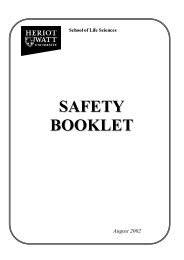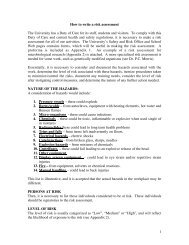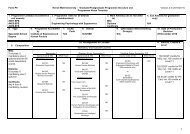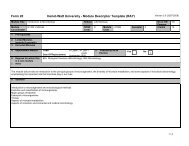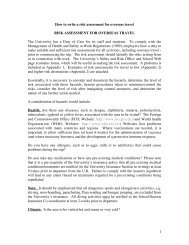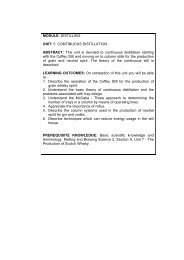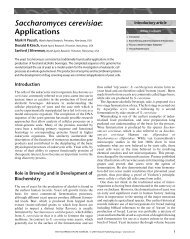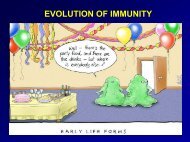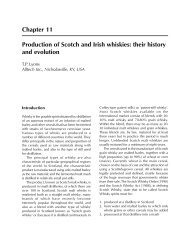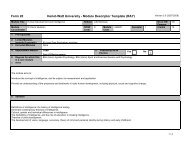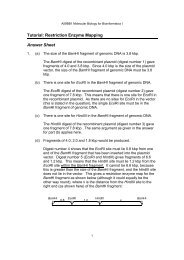Big Five Factors of Personality and Replicated Predictions of Behavior
Big Five Factors of Personality and Replicated Predictions of Behavior
Big Five Factors of Personality and Replicated Predictions of Behavior
You also want an ePaper? Increase the reach of your titles
YUMPU automatically turns print PDFs into web optimized ePapers that Google loves.
BIG FIVE PREDICTORS<br />
419<br />
prone to memory errors or desirability biases. In particular, the<br />
first six <strong>Behavior</strong> Report Form items might be problematic in this<br />
regard—the items that represent self-ratings <strong>of</strong> attractiveness, intelligence,<br />
popularity, masculinity–femininity, religiosity, <strong>and</strong><br />
honesty.<br />
Because <strong>of</strong> a well-founded concern about the psychometric<br />
properties <strong>of</strong> the present behavior criteria, empirical evidence <strong>of</strong><br />
their validities is <strong>of</strong> some interest. One can estimate such validities<br />
by, for example, correlating the participants’ self-reports on the<br />
behavior items with the reports <strong>of</strong> independent observers. I was, in<br />
fact, able to do this in the present study using data collected<br />
previously by Paunonen <strong>and</strong> Ashton (2001a). In that earlier study,<br />
we had participants living in a university residence (N 141)<br />
complete the <strong>Behavior</strong> Report Form in its usual self-rating format.<br />
We then asked each participant’s roommate to complete that<br />
questionnaire in a peer rating format, providing an independent<br />
report <strong>of</strong> each person’s behavior.<br />
The correlations between self-ratings <strong>and</strong> roommate ratings on<br />
each <strong>Behavior</strong> Report Form item, based on Paunonen <strong>and</strong> Ashton’s<br />
(2001a) data, are listed in Table 5, ordered by magnitude. (Correlations<br />
could not be computed for three <strong>of</strong> the <strong>Behavior</strong> Report<br />
Form items—fraternity membership, use <strong>of</strong> diabetes medication,<br />
<strong>and</strong> use <strong>of</strong> depression medication—because <strong>of</strong> a lack <strong>of</strong> response<br />
variance.) The validity estimates for the <strong>Behavior</strong> Report Form<br />
items ranged in size from .12 to .92, with the mean <strong>of</strong> .52. For three<br />
<strong>of</strong> the four computed behavior criteria used in this study, the<br />
self–peer correlations were as follows: preference for contact<br />
lenses .90, mean number <strong>of</strong> traffic violations .49, <strong>and</strong> total<br />
medication usage .45. (The computed obesity index could not be<br />
evaluated for validity because roommate judgments <strong>of</strong> weight <strong>and</strong><br />
height were not collected.)<br />
The sizes <strong>of</strong> the self–peer correlations for the present behavior<br />
ratings gain perspective if one compares them with typical results<br />
for personality measures. The mean correlation <strong>of</strong> .52 shown in<br />
Table 5 is as high as the .52 mean convergent validity reported by<br />
Paunonen <strong>and</strong> Jackson (1985, Table 2) between self-ratings <strong>and</strong><br />
roommate ratings on the trait scales <strong>of</strong> the <strong>Personality</strong> Research<br />
Form (PRF; Jackson, 1984). The .52 mean value for the <strong>Behavior</strong><br />
Report Form items is even higher than the .43 mean self–peer<br />
correlation reported for the domain scales <strong>of</strong> the NEO–PI–R<br />
(Costa & McCrae, 1992, Table 8). Unlike the present single-item<br />
measures, however, the PRF trait scales are 16-item measures, <strong>and</strong><br />
the NEO–PI–R domain scales are 48-item measures. Validity<br />
estimates for those personality scales, therefore, benefit from the<br />
aggregation <strong>of</strong> items. What is the size <strong>of</strong> the correlation between<br />
self <strong>and</strong> peer for only a single item on the PRF or the NEO–PI–R?<br />
If one uses the Spearman–Brown formula (Lord & Novick, 1968,<br />
p. 114) <strong>and</strong> assumes that the self-rated <strong>and</strong> peer-rated personality<br />
scales have reliabilities <strong>of</strong> .70 for the PRF <strong>and</strong> .90 for the NEO–<br />
PI–R (close to those scales’ values reported in their respective<br />
manuals), the expected correlation between self-ratings <strong>and</strong> peer<br />
ratings on any single personality item is only .10 for the PRF <strong>and</strong><br />
.09 for the NEO–PI–R. As is evident in Table 5, the single items<br />
<strong>of</strong> the <strong>Behavior</strong> Report Form well exceeded this region <strong>of</strong> measurement<br />
validity (a notable exception being the .12 correlation<br />
between self-ratings <strong>and</strong> peer ratings <strong>of</strong> attractiveness).<br />
Note in Table 5 that the relatively high correlations between<br />
self-reports <strong>and</strong> peer reports on some variables are not unexpected,<br />
such as whether one wears glasses (r .86) <strong>and</strong> contact lenses<br />
Table 5<br />
Self–Peer Correlations for <strong>Behavior</strong> Report Form Items<br />
Item no. Item label r<br />
9a Tobacco consumption .92<br />
9b Number <strong>of</strong> cigarettes .92<br />
19c Wears contacts .90<br />
19b Wears glasses .86<br />
18a Asthma medication .84<br />
20a Part-time work .73<br />
10b Number <strong>of</strong> drinks .70<br />
19a Eyesight .69<br />
7 Grade-point average .66<br />
21c Routinely exercises .65<br />
10a Alcohol consumption .64<br />
11 Liberal arts .60<br />
15 Buys lottery tickets .60<br />
13b Speeding tickets .58<br />
21b Participation in sports .58<br />
14 High school grade .57<br />
20b Part-time hours .56<br />
21a Plays musical instruments .56<br />
5 Religiosity .55<br />
13a Driving experience .52<br />
18b Allergy medication .45<br />
21d Blood donations .42<br />
8b Dating variety .41<br />
12b Fraternity interest .39<br />
13d Other traffic violations .38<br />
8a Dating frequency .37<br />
2 Intelligence .35<br />
13c Parking tickets .34<br />
13e Driving fast .33<br />
17 Dieting behavior .32<br />
4 Femininity .30<br />
18e Other medication .30<br />
6 Honesty .23<br />
3 Popularity .21<br />
16 Parties attended .20<br />
1 Attractiveness .12<br />
12a<br />
Fraternity membership<br />
18c<br />
Diabetes medication<br />
18d<br />
Depression medication<br />
Note. Empty cells indicate that the correlation was not computed for the<br />
item because <strong>of</strong> lack <strong>of</strong> response variance.<br />
(r .90), works at a part-time job (r .73), takes asthma<br />
medication (r .84), or participates in sports (r .58). But there<br />
are other variables with high validities that are, perhaps, somewhat<br />
surprising. Those variables include ratings <strong>of</strong> alcohol <strong>and</strong> tobacco<br />
consumption (r .64 <strong>and</strong> .92, respectively) <strong>and</strong> estimates <strong>of</strong><br />
number <strong>of</strong> drinks imbibed per week (r .70) <strong>and</strong> cigarettes<br />
smoked per day (r .92). One might expect self-ratings <strong>of</strong> those<br />
less-than-desirable habits to show somewhat lower consensus with<br />
peer ratings, because <strong>of</strong> a penchant for some people to minimize<br />
the presence <strong>of</strong> negative attributes in rating themselves, especially<br />
in an experimental context, but not necessarily in rating others.<br />
As surmised previously, self-ratings requiring more subjective<br />
judgments were not as highly correlated with the corresponding<br />
peer ratings. Specifically, ratings <strong>of</strong> attractiveness, popularity,<br />
honesty, femininity, <strong>and</strong> intelligence were near the bottom <strong>of</strong> the<br />
list in Table 5, with a mean estimated validity <strong>of</strong> only .24. The<br />
reason for their lower overall validity is probably that self-ratings<br />
on those variables are subject to self-enhancement biases that are



